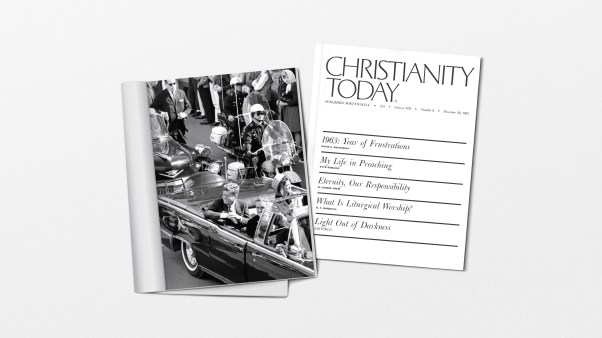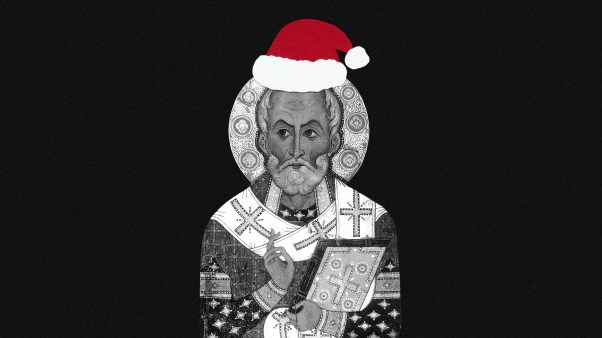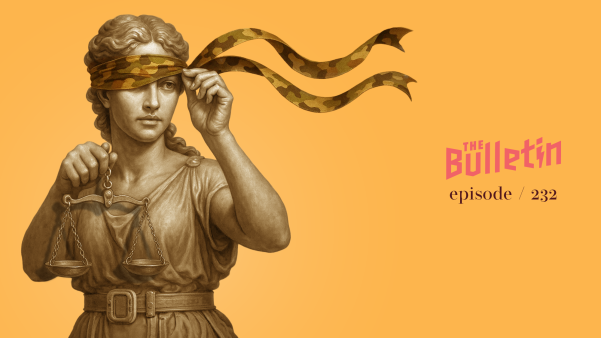Anglican Erich Junger has seen a lot in his wide-ranging career as an enlisted sailor in the US Navy, a medical examiner, a police detective, and a crime scene analyst.
More than a decade ago, his calling shifted to a different kind of investigation. It’s careful work, sometimes secretive and sensitive. He goes after a master manipulator, an enemy responsible for physical, psychological, and spiritual havoc.
Well, not just any enemy. The Enemy.
An exorcist in the Anglican Church of North America, Junger now dons a clerical collar as he advises fellow believers to “put on the full armor of God, so that you can take your stand against the devil’s schemes” (Eph. 6:11).
Scriptural directives to defend against the Devil take on a heavy urgency once you have seen the twisted work of Satan up close, again and again. Junger dedicated his ministry to studying spiritual warfare—specifically, the physiological effects of demonic activities—back in 2007. Ten years later, he became licensed as an exorcist.
To outsiders, the work of exorcism carries significant cultural baggage, whether due to misperceptions gleaned from the movies or the many real-life cases where possession had been faked or confused with mental illness. This is tricky spiritual territory to navigate. That’s why exorcists like Junger would say their expertise in identifying and combating the presence of the demonic is so crucial right now.
This realm of ministry remains particularly mystifying in the United States, where most Christians see Satan as a symbol of evil rather than a living being, according to Barna Research.
“Many priests and ministers of most all denominations have lost their sense of the reality of Satan as a real entity bent on our destruction,” Junger said. “Instead, they either don’t preach about what has always been clearly stated in sacred Scripture, or they minimize the extent.”
Ministers specializing in spiritual warfare attest that as long as Christians downplay the threat of Satan, the more vulnerable they will be to his advances. As Peter wrote, “Your enemy the devil prowls around like a roaring lion looking for someone to devour” (1 Pet. 5:8).
C. S. Lewis, in The Screwtape Letters, warned of two dangerous errors regarding devils. “One is to disbelieve in their existence. The other is to believe, and to feel an excessive and unhealthy interest in them,” Lewis wrote. “They themselves are equally pleased by both errors and hail a materialist or a magician with the same delight.”
Evangelicals of different times and traditions have fallen to both. In recent years, Protestant exorcists on both sides of the theological spectrum—liturgical traditions like the Anglican Communion and spirit-filled charismatics—have reported an uptick in interest. They keep busy in places like Latin America and Africa and say they are also seeing more demand in the US.
One of the most popular sessions at last year’s Q Ideas conference was an exorcism discussion with a Catholic demonology expert, Adam Blai, who discussed how he interacts with Protestants who want to understand and fight possession.
“How can we be Christians and not try to better understand what’s happening in the spiritual realm?” founder Gabe Lyons asked after 80 percent of Q attendees said their churches rarely or never discussed the topic. “Isn’t that a pretty big deal to what we believe is actually going on in the world?”
This year, for the first time, a handful of Protestant ministers—Junger and four others—joined the Vatican’s annual training on exorcism and deliverance. Catholics, Protestants, and Orthodox may have different beliefs and practices, but they certainly have a common enemy.
The new partnerships may make way for a more ecumenical era for exorcism, and, God willing, will better equip the global church to face and fight its literal demons.
Junger, an American based in Bangkok, Thailand, traveled to Rome last May for the Catholic church’s exorcism conference. The setting resembled a university lecture, with around 250 people sitting in green auditorium seats, hearing from panelists—theologians, neuroscientists, and anthropologists—on methods for addressing demonic possession.
Exorcism generally refers to spiritual efforts to expel evil spirits from people (or sometimes places or objects) believed to be possessed. Prayers of deliverance or liberation tend to be used in cases of broader spiritual bondage or oppression.Both rely on God’s authority to cast out evil spirits, as Jesus himself did repeatedly in the New Testament.
“Deliverance prayer seeks to bolster and strengthen the victim as well as repel the external forces that are oppressing them,” Junger said. “Exorcism is a direct assault on the demon who has gained total control and is now a ‘soul-squatter.’ ”
The definitions and approaches differ between traditions, and many Protestants don’t differentiate between the two.
As Pedro Barrajón, a Catholic priest and one of the conference organizers, told The Telegraph, “The Catholic rite is very structured, whereas some of the other churches are more creative, they don’t use a precise format.”
Exorcism tends to be affiliated with Catholics, thanks to the tradition’s historic adoption of the practice as well as its place in the popular imagination. The centuries-old practice has been reclaimed by the Catholic church in recent years, with the Vatican formally recognizing the rite in 2014 and the US Conference of Catholic Bishops offering priests an English version of the Vatican’s exorcism handbook in 2017.
Soon after his election, Pope Francis himself performed an impromptu exorcism in St. Peter’s Square on a young man who, according to an accompanying priest from Mexico, was believed to be possessed.
“Pope Francis and many Catholic exorcists believe that battling the Devil and his minions is of such urgency and import that it’s better to join forces with Protestant demon fighters than compete with them,” said Andrew Chesnut, chair in Catholic Studies at Virginia Commonwealth University.
Only five Protestants came to the Catholic exorcism conference: three Anglicans, a bishop in the Independent Lutheran Charismatic Church in Argentina, and an evangelical psychologist from Hong Kong. Junger said the invitation “makes everyone realize just how real and pervasive” the problem of demonic presences has become.
Pagan Popularity and Pop Culture
It’s a global battle, but one that has been obscured by disenchanted, Western thinking, exorcists say. Many Christians have forgotten about demons altogether, occasionally referring to “spiritual warfare” without thinking much about the Enemy on the other side.
In the US, Protestant churches aren’t the ones suddenly talking more about demons—pagans are. Some Christians are starting to pay more attention to dark presences because of their New Age neighbors who are bringing back occult rituals, according to Benjamin McEntire, an appointed exorcist in the Communion of Evangelical Episcopal Churches.
Witchcraft and other occult practices, from charging crystals to reading tarot cards, are making their way into the mainstream as New Age traditions have experienced a massive rise in recent years. (The latest Pew Research Center figures had Wiccans and pagans at about 1–1.5 million US adults in 2014.) Though hexes and dark magic aren’t typical for today’s witches, they still recognize the power and presence of demonic forces.
Satan is also making a comeback on the small screen, including shows like Netflix’s Chilling Adventures of Sabrina (which turned out much more spiritually dark than its Archie comic origins). And just this fall, CBS added a procedural drama where a priest-in-training and psychologist investigate possessions and other unexplained phenomena. The show is called Evil.
Of course, films and TV shows sensationalizing demonic possession always spike interest in the real thing. Many denominations “are being ‘reawakened’ to the reality of demonic activity in the world,” Junger said, “particularly since secular society has worked so hard at destroying the notion of demons and demonic activities.”
Exorcists are trained to look for signs of demonic activity that the rest of us might ignore. Some point to habits like compulsions related to sinful behaviors, intrusive evil thoughts that persist despite corrective effort, and disruptions during holy activities.
“Many practitioners have learned ways to test the difference using prayer exercises,” said McEntire, a Protestant who also attended the Vatican event. “I’ve seen people blocked from physically repeating fairly mundane prayers, the confession and renunciation of specific sins, to the point that they had to strain to pray the words.”
A priest and chaplain from Alaska, McEntire began to focus on spiritual warfare in college. He wrote his dissertation on exorcism and deliverance at Ashland Theological Seminary and went on to dedicate his career to helping people escape and recover from spiritual bondage.
“While most groups allow for the possibility that believers can be subjected to bondage, many reject that possibility and miss signs of demonization in believers,” the 37-year-old said. “Demonization in Christians is highly controversial in evangelical circles, with strong opinions on both sides of the debate.”
Many evangelicals believe that the Holy Spirit dwells within his people and that his presence would be enough to defend against possession.
Demon-Hunting Across Denominations
McEntire attended the Rome conference to better understand the Catholic perspective and to make connections for building Christian unity in these ministries as the global church enters a new era in defending against demonic possession.
“It makes sense that those who are confronting the same enemy in the name of the same Lord would do so together,” said McEntire, who is writing a book comparing exorcism and deliverance ministries, “but currently there’s still a significant amount of institutional isolation with minimal formal communication and dialogue.”
Historically, Catholic, Protestant, and Orthodox scholars have not engaged one another’s approaches to addressing demonic possession—or the traditions have focused on dismissing outside techniques.
“During previous centuries we witnessed competing Christian denominations decrying each other’s deliverance practices,” said Kate Kingsbury, an anthropologist at the University of Alberta. “Especially during the Reformation and Counter-Reformation when ostensible misuse of exorcism and other related practices might entail one be burned as a heretic.”
Amid efforts to form a united front “against Satan and his allies,” some denominational differences may be hard to overcome. The major fault lines fall around the difference between exorcism and deliverance, who can perform exorcisms, and whether Christians themselves can come under bondage to demons.
Catholics require an ordained priest and permission of a bishop for exorcisms, while Pentecostal movements rely on the Spirit’s prompting in the moment, tailoring the response to the victim before them.
Even within the structure of the church, the Catholic Charismatic Renewal movement has been the current vanguard for exorcisms. With lively worship services that could be confused for the praise nights of Protestant Pentecostals, this expression of Catholicism, especially in places like Africa and Latin America, has fueled demand for exorcisms, calling on the power of the Spirit to deliver, heal, and see people baptized in the Holy Spirit.
Some Protestants have gleaned from prominent Catholic charismatics like Francis and Judith MacNutt and Catholic deliverance pioneer Neal Lozano.
Other Causes of Suffering
Across denominations, all professional demon-hunters must take on this work carefully, particularly as they navigate other potential causes for seemingly “possessed” behavior.
Critics still consider exorcisms to be harmful relics of an ancient, superstitious age. Misdiagnoses can and have heaped further suffering on victims. Historically, overzealous exorcists have tortured troubled children in what amounts to child abuse and kept the unwell from seeking medical treatment.
It took 400 years before the Vatican’s exorcism guidelines finally, in 1999, drew distinctions between possession and mental and physical illness. This is a crucial area for today’s exorcists. Gary Thomas, an American Catholic exorcist, has worked with doctors and psychiatrists to standardize a means of ruling out other causes of suffering like schizophrenia and bipolar disorder before diagnosing demons.
“It’s important to differentiate between psychopathic illnesses, neurasthenia, pathologies,” Cardinal Ernest Simoni said in his keynote during last year’s Vatican conference. “Satan you can recognize.”
To combat potentially abusive or antiscientific practices, the organizers emphasized a multidisciplinary approach, bringing together practitioners not just across the church but also psychology, medicine, sociology, and law.
Indeed, medical help is now seen as a first response when possession is suspected.
“My experience and reading suggest that if someone you know is thought to be suffering from the presence of evil spirits, the first action is to seek medical help,” Graham H. Twelftree, of the London School of Theology, wrote in Premier Christianity. “There are likely to be natural causes to the suffering, and medical responses that will bring healing. If mature, wise, and widely respected Christians are of the opinion that there is a demonic dimension to the suffering, in the company of at least one other Christian, there can be a time of prayer for the person.”
This sense of pragmatism and perspective has improved Protestants’ approach to suspected cases, McEntire said, by “not assuming everything is demonic and focusing less on the Enemy and more on helping the person address the sources of bondage.”
Exorcism’s Resurgence
The Devil may be everywhere, but evangelical exorcists are not nearly so pervasive—yet.
Vincent Lampert, an exorcist for the Archdiocese of Indianapolis, told The Atlantic last year that he received 1,700 requests between January and October, the most he’d ever received. Other priests said if they didn’t have their support networks, exorcism work would take up all their time.
“Exorcism has become such a hot commodity, so to speak, that I foresee some evangelicals who have historically shied away from it embracing it in the near future,” Chesnut, the Catholic studies professor, said. “We can’t forget that the future of Christianity is in the Global South, especially Africa, where the belief in demonic possession is common currency.”
Other Protestant denominations may increasingly follow in the footsteps of Pentecostals, adopting practices that resonate with indigenous populations. In the US and Western contexts, the fight may enlist spiritual and technological forces.
At last year’s exorcism conference, mobile phones were included for the first time alongside the more traditional “spiritual paraphernalia of holy water, Bible, and crucifix.” That means priests are starting to encourage exorcisms from afar, via phone calls and Skype.
“This explosion of exorcism services in virtual spaces, I posit, may also lead to increasing popularity and acceptance of demonic deliverance in ever wider circles,” said Kingsbury, the anthropologist.
But even as interest in these practices grows, they remain specialized and deliberate. There is no one method for determining whether a person is possessed, no single incantation that can rid the body of evil spirits.
Instead, as Junger has learned, it is an active investigation. He must know as much as he can about the victim and the demons he asks God to expel.
He declined to elaborate much on the latter. Saying too much can fuel fakers who want to discredit the kind of work he does, as well as feed psychoactive affective disorders, he said.
“The specific signs we look for cannot be affected or mimicked by a fraudster, which is also why detailed investigations must be undertaken to precisely know as much as we can about the person’s background,” he said. “Everything you saw in The Exorcist movie is something that can either be faked or carried out through mental illness.”
Some exorcists describe a change in the irises of the victim’s eyes. Or uncanny abilities to know things they shouldn’t be able to know, like suddenly speaking a different language or being aware of where the priest has hidden holy items.
In one talk, Junger mentioned how demons may recall past sins committed by the exorcist himself. “When they’re telling you things that happened when you were 10 years old and no one but you could know that, you get a clue real quick that this is not a game.”
As more Christians wake up to the evil he has actually looked in the eye, he is hoping their churches—whether Catholic, Protestant, or Orthodox—will be there to offer sound support and powerful defenses against darkness.
“The more we work together in sharing cases, attending mutual training sessions, and talking with one another about how we can handle these cases is key,” he says. “Once we break down the denominational barriers and work together as Christians first, just as the original church did, then we will give Satan a real run for his money, thanks to the grace of God.”
Griffin Paul Jackson is a writer in Chicago.










